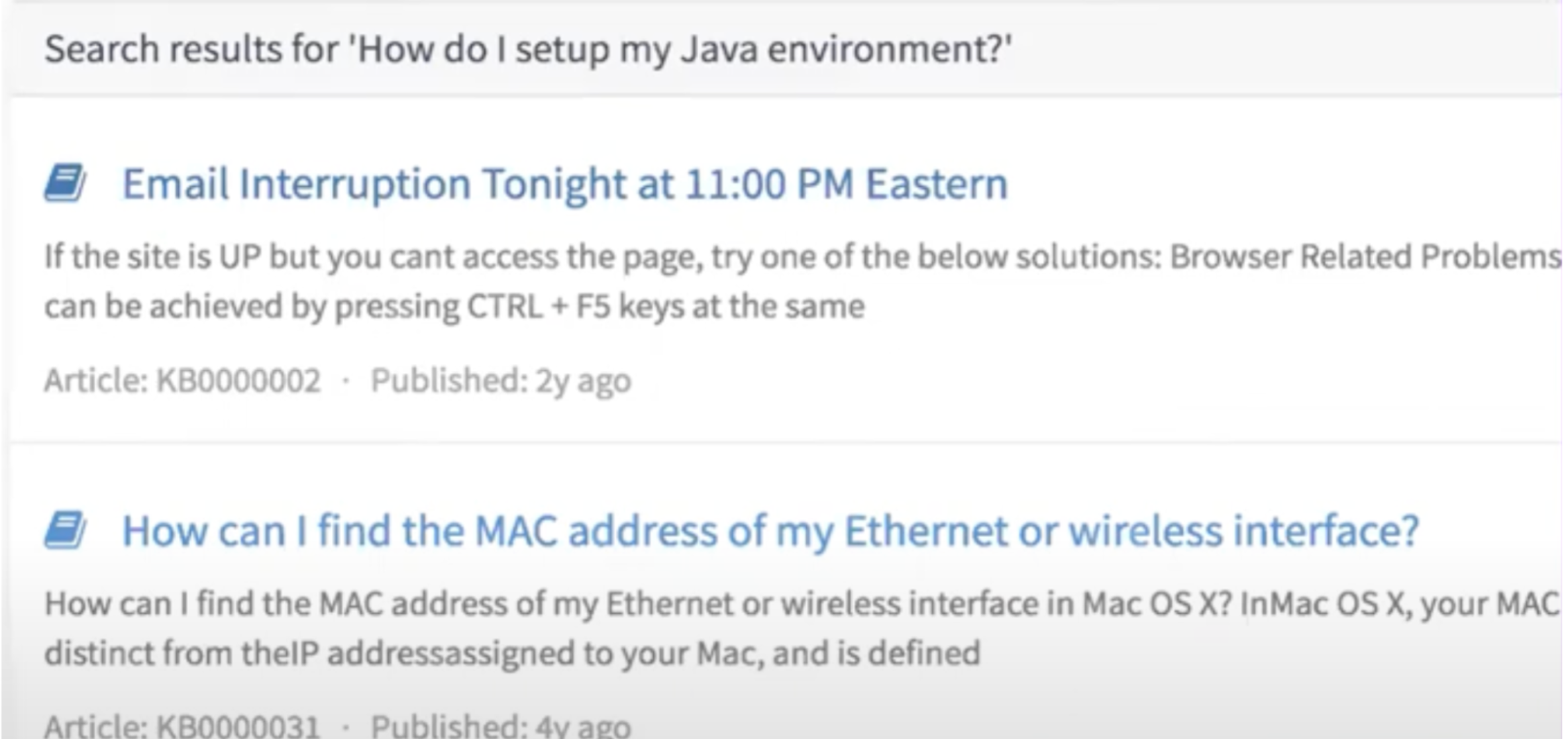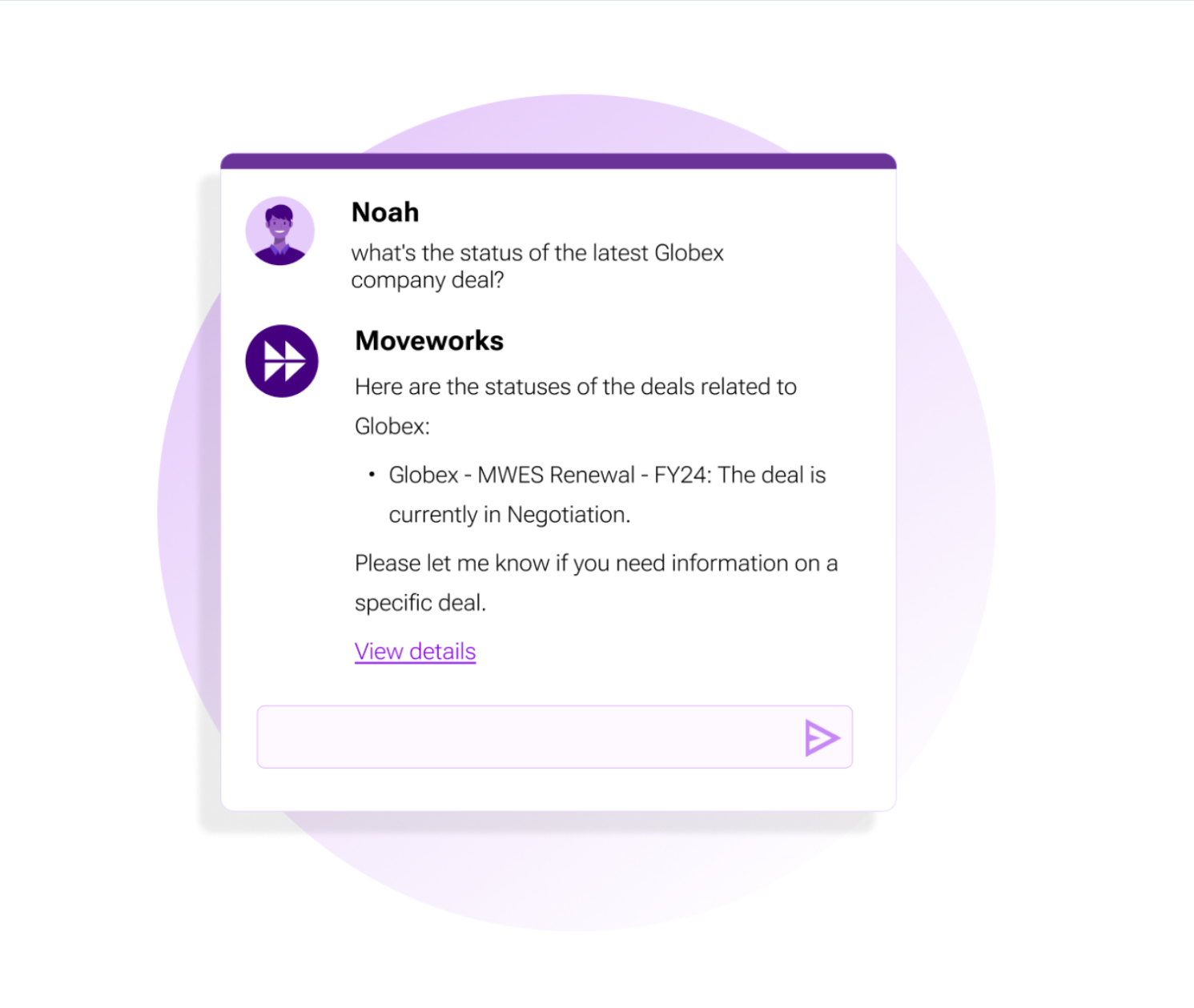Table of contents
Feeling lost in a sea of information? Imagine searching for a document and coming up empty-handed, or struggling to find the answers to simple questions about your job. Maybe your workplace search is leaving you high and dry. Inaccessible information may hinder your team’s focus on strategic initiatives and reduce service quality.
So what’s a business leader to do? The answer lies in better workplace search.
With AI-powered workplace search, those days are ending. Get the information you need, when you need it, and unlock a whole new level of productivity. In this blog, we’ll define workplace search, discuss current approaches, and share how when search is paired with automation it can help to unlock new levels of productivity.
What is workplace search?
Workplace search is primarily focused on helping employees to find information within their specific company or organization. Its scope is typically limited to internal documents, emails, files, and other company-specific resources.
What are the benefits of workplace search?
Knowledge is the fuel powering your workplace. It is critical for project management, collaboration, and decision making. However, without a centralized, robust search capability, this information may remain trapped in silos, hindering efficient problem-solving and decision making. So what are some of the potential benefits of workplace search?
- Improved employee productivity
- Enhanced collaboration
- Faster knowledge access
- Better decision-making
- Simplified onboarding with easy information access
Workplace search may improve employee productivity by providing quicker access to relevant information, enhance collaboration by connecting employees with experts and resources, facilitate faster knowledge access, and support better decision-making too. Additionally, workplace search may simplify onboarding by providing new employees with easier access to company information.
What’s the difference between workplace and enterprise search?
Some may use workplace search and enterprise search interchangeably, however workplace search mostly refers to a specialized tool designed for internal use within an organization, while enterprise search is a more general term that can encompass both internal and external data sources, and whose users could include employees, customers, partners, or other stakeholders. Both are critical solutions to helping employees find and access the information they need.
Key search areas and knowledge types
With search, you and your employees seek out correct information for questions ranging from basic support questions to critical internal documentation. Workplace search is about much more than simply finding documents; it can span across different areas and help to unlock the collective knowledge of your entire organization.
Additionally, your search platform should offer robust access controls, ensuring that users only see the content they're authorized to view. Here are some of the knowledge types search helps to demystify:
File and document search
- Finding relevant documents across various formats like PDF, .docx, .pptx, Google Docs, or Google Slides
- Text search capabilities
- Advanced search filters and options
People search
- Locating experts and colleagues
- Searching by departments or locations
Knowledge base search
- Company-specific knowledge and information
- Integrating with existing knowledge management systems
Project and task search
- Finding relevant projects, tasks, and deadlines
- Tracking project progress and status
External search
- Searching across external sources (i.e. Zoom’s Help Center)
System and integration search
- Searching for data from sources including: Application management (AMS), collaboration tools, customer relationship management (CRM), financial management (FMS), identity and access management (IDAM), IT operations, human resource information (HRIS), marketing, procurement, project management system, and other systems
How does workplace search work?
With consumer search tools like Google readily available, you might think, "Search? That's easy!" But when it comes to workplace search the situation is far from simple.
Most organizations have a vast ocean of data that search tools need to navigate, ranging from structured data neatly organized in databases to unstructured content scattered across emails, documents, and multimedia files. Additionally, workplace search tools often require more specificity and accuracy than a typical Google search, necessitating more refined and advanced search techniques.
At its core, workplace search solutions work by crawling and indexing content from all your different data sources, like file shares, intranets, and databases — both unstructured and structured data sources. They build a centralized "map" of sorts, allowing users to quickly search and retrieve information from across the organization in one place. This allows users to quickly search and retrieve information from across the organization in one place.
Limitations of some workplace search tools
Your employees rely heavily on search to find the information they need, resolve challenges, and stay up to date on everything happening across your organization. However, keyword-based search tools can often fall short with limited search capabilities, inconsistent information across silos, or difficulties in securely accessing information dispersed across systems and applications.

Irrelevant search results can be common with traditional keyword search tools
Challenges in workplace search
Workplace search tools offers many benefits, however, there a number of factors that may limit the performance of standard search tools:
- Data format limitations: Many search tools are restricted to specific file formats, such as documents or spreadsheets.
- Data privacy and security concerns: When allowing unified access across all repositories, you should look for software that can adhere to the right permissions and helps to ensure access for authorized users only.
- Language barriers: Organizations with a global workforce encounter difficulties when search tools are primarily designed for a single language, rather than a multilingual global workforce.
- Integration challenges: To deliver a cohesive user experience and comprehensive search results, seamless integration with CRM, HR, asset management, ITSM, and other critical systems may be essential for search tools.
However, not all workplace search is created equal. As technology has advanced, we've seen a shift from traditional keyword-based search to more intelligent, AI-powered approaches. This new technology enables companies to utilize advanced techniques to not only find information but also to uncover valuable insights.
How AI augments workplace search for the enterprise
AI-powered search is a game-changer for organizations looking to unlock the full value of their information assets. Compared to traditional search, this new technology allows companies to leverage advanced techniques to not just find information, but also to uncover insights too.
- Natural language processing (NLP): NLP enables computers to understand, interpret, and generate human language. In the context of search, NLP allows users to ask questions in plain, everyday language rather than relying on specific keywords. The AI search engine can then parse the query, understand the intent behind it, and deliver more relevant results.
- Machine learning and relevance: Another key aspect of AI in search is machine learning, particularly when it comes to relevance and ranking. Machine learning algorithms can analyze user behavior, learn from past searches, and continuously improve the relevance of search results over time.
- Knowledge graph and entity understanding: AI-powered search engines can also leverage knowledge graphs to better understand the relationships between different entities within enterprise data. A knowledge graph is essentially a map of all the key concepts, people, places, and things within an organization's knowledge base, along with the connections between them.
- Conversational interfaces: With the power of NLP, users can engage in back-and-forth dialogues with conversational AI assistants, refining their queries and diving deeper into specific topics. This natural, conversational approach to search makes it easier for users to find what they need. Plus, conversational AI assistants can learn from each interaction, potentially getting smarter and more helpful over time.
AI-powered search tools, leveraging NLP and machine learning, can better understand and interpret enterprise data than traditional keyword-based tools. This can lead to more accurate and relevant search results.
Moveworks' agentic AI copilot, powered by advanced reasoning capabilities, is able to infer user intent, enabling it to provide more helpful responses, and suggest potential next steps. These agentic capabilities help to demonstrate the difference between basic keyword search solutions and more intelligent, AI-driven approaches.

What to look for in workplace search software
Modern AI-powered search software goes beyond simple keyword searches. It can summarize complex documents, understand your search intent, handle massive amounts of data, translate information across languages, use permissions to bolster security, deliver accurate results, integrate seamlessly with other tools, and be customizable to fit your specific needs.
This comprehensive set of features makes it a valuable asset for any organization looking to improve efficiency, productivity, and access to information. However, the most advanced workplace search tools go beyond simply finding information– they allow your employees to take action too. Scheduling meetings, generating reports, or updating systems of record — whenever possible each of these actions should be triggered by the original search.
Workplace search is only the beginning
For most companies, improving enterprise search is only the beginning. To truly revolutionize search, consider evolving beyond basic information retrieval. It’s only by also adding automation to your search that you can begin to unleash new frontiers in productivity.
By infusing reasoning capabilities into our search capacities, Moveworks enables workplace search that not only understands the nuances of information retrieval, but is able to initiate certain autonomous actions too.
Just imagine what’s possible when search and automation work together seamlessly to free your employees and support team from mundane tasks. The potential for more employees to become quickly unblocked and to independently resolve a vast majority of their issues, from managing conference room bookings to resetting passwords to submitting PTO requests to updating and tracking expense reports, managed and automated with the power of agentic AI.
This isn't a dream; it's the potential of a truly advanced agentic enterprise search solution. The Moveworks Copilot, powered by our reasoning engine, helps enable your employees to search for information, take action across numerous use cases, and allow for greater productivity too.
Want to learn more about optimizing search, automation, and productivity for IT teams? Check out our IT leader’s guide: 3 must-haves for enterprise copilot success (Hint: One of them is search!)



